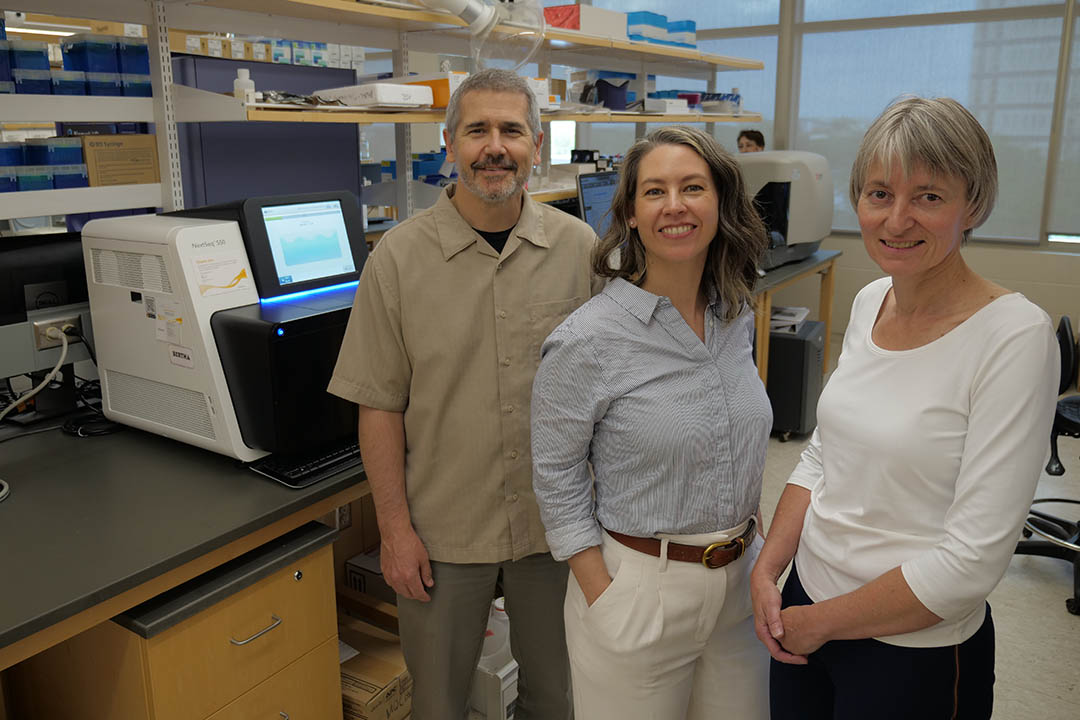
USask launches world-first clinical trial to improve ovarian cancer treatment
SASKATOON – A new University of Saskatchewan (USask)-led clinical trial aims to substantially improve quality of life for ovarian cancer patients, and making it part of routine clinical testing, while also reducing costs.
USask gynecologic cancer physicians, working closely with USask pathology doctors, will test ovarian cancers patients’ tumours for a range of mutations that predict response to a new class of drugs. By combining multiple tumour test methods together for the first time, patients will get more accurate, personalized, genomic information about their tumours than was previously possible. This information will help patients make more informed choices about their own care, including more precise estimates about the benefits of these drugs.
“For the first time, we will be able to give ovarian cancer patients very specific information about their chances of responding to treatment,” said Dr. Laura Hopkins (MD), provincial lead for gynecologic oncology at USask’s College of Medicine and the Saskatchewan Cancer Agency, and co-leader of the research team. “This trial will also bring research opportunities for new treatments to the point of care and open the gateway for scientists to become partners in care.”
This research was made possible thanks to close collaboration at USask between doctors and researchers, and $3.8 million in funding. In 2021, financial support from Ovarian Cancer Canada and the provincial government of Saskatchewan paved the way for the team to establish Saskatchewan’s first biobank for ovarian tumour tissue.
Most recently, a generous gift in honour of Donald E. Kramer was made by his family, working through the Cancer Foundation of Saskatchewan, for the Saskatchewan Cancer Agency to purchase a new, leading-edge, next-generation genetic sequencing tool.
“With this new technology, we can predict response to a given treatment and quantify the amount of benefit,” said Hopkins. “This type of research has not been done previously by any other cancer program and will be first in Canada.”
Ovarian cancer is the most fatal gynecologic cancer—only 40 per cent of patients survive more than five years after diagnosis. Advanced disease–where the cancer has spread out of the pelvis and into the upper abdomen—is not curable and treatment options are limited to a combination of surgery and chemotherapy.
The current, standard ovarian cancer tumour testing practice in Canada tests only for the absence or presence of a mutation to one set of tumour-suppressing genes—this identifies only a fraction of patients with genetic changes in their tumour.
“Previously, we could only guess which patients would respond to treatment,” said Hopkins. “This led to over-treatment of many patients—up to 25 per cent—receiving therapy from which they would not benefit and from which they experienced side effects and decreased quality of life.”
Co-led by USask gynecologic pathologist Drs. Mary Kinloch (MD), division head of anatomic pathology with the Saskatchewan Health Authority, and USask molecular pathologist Dr. John DeCoteau (MD), the project involves testing patients’ tumours with four different diagnostic tools at the USask Advanced Diagnostics Research Laboratory, and providing that data directly to oncologists for clinical care optimization.
Specific information about the genomic makeup of the tumour will allow oncologists to work with patients and jointly create a drug treatment plan personalized for each patient’s unique needs—ensuring patients do not take drugs that do not help control their cancer and that worsen their quality of life.
“The paradigm for ovarian cancer care will change in Saskatchewan and across Canada with this trial,” said Hopkins. “This ‘precision medicine’ approach will also save the health-care systems hundreds of thousands of dollars annually, since we will no longer be using a ‘one size fits all’ approach with these drugs.”
Currently, ovarian cancer patients who have responded well to chemotherapy and surgery get one test dictating whether they are eligible for a new drug that works to keep their cancer suppressed. That test only checks for the absence or presence of a mutation to one set of tumour-suppressing genes and misses the other combinations of genetic factors that predict how well a tumour will respond to another new drug.
“This mutation affects the DNA repair pathway—cancer cells that cannot repair damaged DNA cannot recover from the effects of chemotherapy,” said Kinloch. “When the cells are pushed to die instead of repair that is one way to achieve ‘cancer control’ and/or remission.”
About 20 percent of all patients—those who have the tumour-suppressing gene mutation—have excellent outcomes from currently prescribed medication, potentially leading to their cancers going into remission for up to five years and in some cases, include living longer.
For the remaining patients who are eligible for treatment, half benefit from an additional year of cancer remission, whereas the other half get no real benefits but experience all the negative side effects of the drug.
“For this 60 per cent of patients, it is important for us to be able to test their tumours for genetic changes that define and predict response, since the gains are different, and the side effects of the drug they have access to are very different,” said Kinloch. “Currently, there is no way to know who will respond and who won’t.”
“When benefits are small, patient preferences and priorities become extremely important for decision-making,” she said.
The research team will use four different diagnostic platforms, combining results, and comparing it to the current ‘gold standard’ for tumour testing—a substantially more expensive test, not currently available to patients in Canada as part of the funded health-care system.
“This testing format will be the first in Canada and the world,” said DeCoteau. “Our results will lead to guideline changes on tumour testing for ovarian cancer patients and how we make clinical decisions needed to deliver the best therapy—hopefully, this provides increased access to tumour testing and increased choices for patients.”
The research team also includes colleagues at University of British Columbia, University of Victoria, the Saskatchewan Health Authority, and the Saskatchewan Cancer Agency.
-30-
For media inquiries, contact:Victoria Dinh
USask Media Relations
306-966-5487
victoria.dinh@usask.ca

